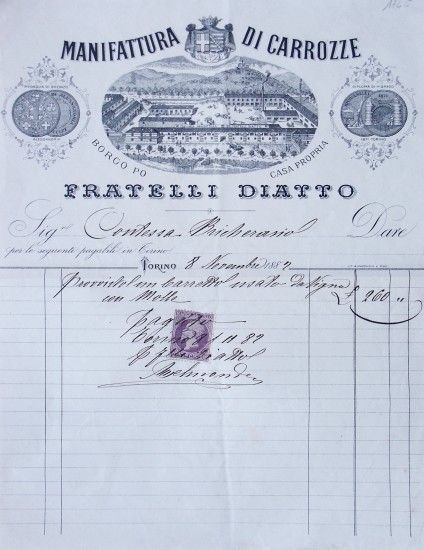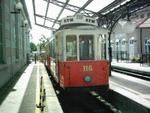1835 : The foundation
|
|
|
1838. The “Diatto perfected wheel” patent |
In 1835, the inventor and businessman Guglielmo Diatto opened a “carradore” (literally “carriage manufacturer”) workshop at Torino, on the banks of the River Po, to manufacture horse carriages.
In 1838 he patented his perfected wheel”, and the business prospered over the following years thanks to a series of other innovations, expanding to the manufacture of trams and railway carriages.
By 1864, the year of Guglielmo’s death, Diatto - now managed by his sons Battista and Giovanni - were not only developing their carriage production, but also well on the way to becoming one of the major European manufacturers of railway equipment.
|
|
|
Invoice dated 8.11.1887 |
The Diatto “Manifattura di Carrozze” (Carriage Manufacture), as we can see from an invoice dated 1887, was already a large industrial concern, established over a vast area owned by the company itself.
At the end of the Nineteenth Century, Diatto was building trains for the following companies: Società Italiana Strade Ferrate del Mediterraneo, Società Nazionale di Ferrovie e Tranvie, Rome, Compagnie des Wagons Lits et Grands Express Europeéns, Paris, and Tran Europe Express, as well as trams for Tramvia Elettrica Torino Tivoli.
In 1918, at the height of the business’s success, the company Società Anonima Officine - previously Fratelli Diatto - (the third largest Italian industrial group), managed by the son-in-law of Diatto, Eng. Dante Ferraris, President of Confindustria and Minister of Labour, became part of Fiat San Giorgio Costruzioni Navali e Meccaniche.
|
|
|
Diatto tram from 1911 |
A few years previously, the young brothers Vittorio and Pietro Diatto, the sons of Battista and grandsons of the company’s founder Guglielmo, became the Inheritors of a major mechanical and railway manufacturer and controlled an enormous fortune.
In 1901, the Diatto brothers were among the first in Italy to buy a Ceirano automobile. It is probable that this experience was central to the decision taken by the brothers four years later, in 1905. (The Biscaretti Ruffia” (Turin) and “Nicolis” (Villafranca, Verona) automobile museums have on display two magnificent Diatto automobiles, the Tipo 20 and Tipo 30).















